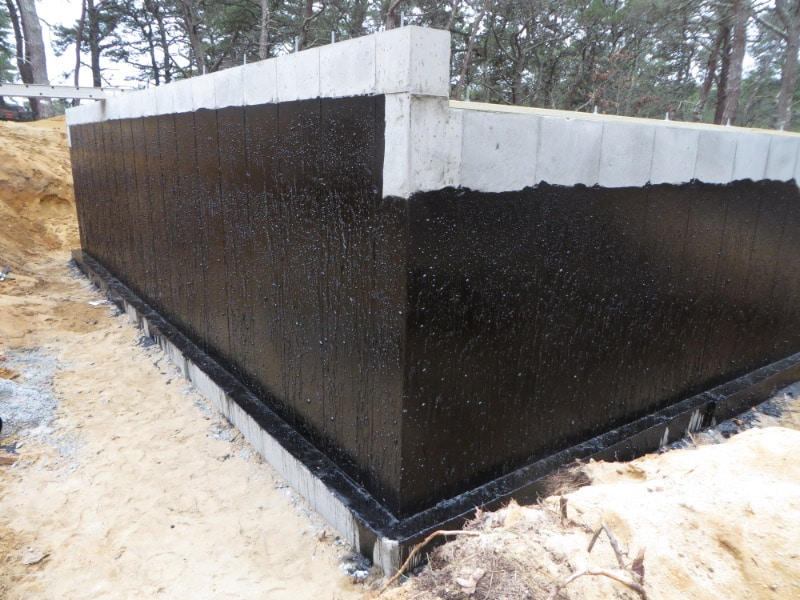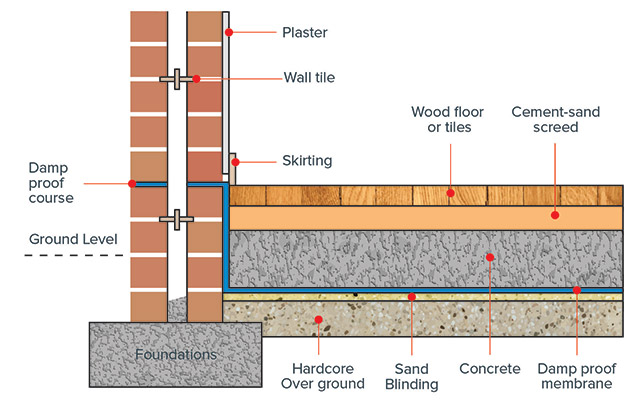Comprehending the Importance of Damp Proofing in Fighting Structural Damages
Damp proofing functions as a vital protection against wetness infiltration in buildings. This protective procedure can stop significant architectural damages, yet many building proprietors continue to be uninformed of its importance. Recognizing the indicators of dampness and understanding the numerous solutions offered can be necessary. However, overlooking damp proofing can bring about serious repercussions. What are the certain dangers and remedies that property owners should think about?
What Is Damp Proofing and How Does It Function?
Moist proofing works as a necessary obstacle versus dampness invasion in buildings. damp proofing newcastle. This procedure includes using specific products and methods to avoid water from permeating wall surfaces, floors, and other structural aspects. Normally, moist proofing can be achieved through the installment of moist evidence membranes, coverings, or using specialized sealants.These techniques work by producing a protective layer that prevents moisture movement, guaranteeing that the interior environment continues to be completely dry and healthy and balanced. Wet proofing is specifically important in locations prone to high moisture or groundwater, as it aids preserve the integrity of the framework over time.Moreover, efficient moist proofing adds to power effectiveness by protecting against warmth loss related to moist settings. By dealing with possible wetness issues prior to they escalate, damp proofing functions as a proactive procedure in securing structures from the damaging impacts of water damages, ultimately extending their life-span and preserving their worth
Usual Indications of Wetness in a Structure
Dampness issues within a building can show up through a number of noticeable signs that indicate the visibility of wetness. One popular indication is the appearance of water spots on wall surfaces or ceilings, which commonly shows dampness infiltration. In addition, peeling off or bubbling paint can suggest that excess moisture is trapped under the surface area, resulting in deterioration. Another typical indication is the existence of mold and mildew, which prosper in moist conditions and can usually be recognized by their moldy odor. Furthermore, a rise in humidity degrees can create condensation on windows and various other surface areas, highlighting wetness troubles. Finally, deformed or unequal flooring may signal underlying wetness that endangers architectural stability. Acknowledging these indications early can aid alleviate potential damages and keep a safe living environment. Regular evaluations and prompt action are important in addressing dampness issues before they escalate.
The Threats of Ignoring Damp Proofing
Ignoring wet proofing can result in considerable risks to a structure's structural stability, as moisture buildup might damage walls and foundations. In addition, extended moisture creates a setting for mold and mildew development, positioning serious carcinogen to passengers. Attending to these dangers is crucial for making sure both security and longevity of the home.
Architectural Stability Dangers
They expose their buildings to substantial structural stability dangers when home owners neglect the relevance of reliable damp proofing. Long term dampness seepage can result in the development of mold, which compromises foundational aspects and can jeopardize overall security. Furthermore, excess moisture can wear down concrete and brickwork, leading to splits and architectural failings. Wood parts are especially susceptible; they can rot and lose load-bearing ability, posturing severe threats to the building's structure. Moreover, untreated wet problems might bring in insects, such as termites, which better aggravate structural deterioration. Ultimately, disregarding wet proofing measures can result in costly fixings and potential safety hazards, highlighting the important function of positive damp administration in maintaining the stability of properties.
Wellness Threat Problems
How can a seemingly small oversight lead to severe wellness dangers? Ignoring wet proofing can produce an atmosphere helpful to mold and mildew growth, which postures considerable wellness risks. Mold spores can set off allergic reactions, respiratory system problems, and other health and wellness difficulties, specifically in at risk populaces such as youngsters, the elderly, and people with pre-existing conditions. Furthermore, consistent dampness can bring in insects like rodents and bugs, which lug illness that better endanger health. The presence of wetness likewise adds to a decrease in interior air quality, aggravating bronchial asthma and various other breathing ailments. Consequently, the failure to resolve wet problems not just threatens structural honesty but also threatens the well-being of residents, highlighting the important requirement for efficient damp proofing actions.
Different Kinds Of Damp Proofing Solutions
Various variables can add to damp concerns in buildings, selecting the proper damp proofing option is crucial for maintaining architectural stability. Several options are offered, each customized to particular conditions.One typical option is a damp-proof membrane layer (DPM), generally made of polyethylene or asphalt, which is mounted in floorings and wall surfaces to avoid wetness access. An additional alternative is damp-proof training courses (DPC), which are layers of water resistant product placed within walls to block climbing damp.Chemical damp proofing involves injecting waterproofing chemicals into walls to develop an obstacle against wetness. Additionally, external treatments such as tanking, which entails using a water-proof layer to the beyond foundations, can be reliable in stopping water penetration.Each solution has its benefits and is selected based on the structure's specific concerns, environmental conditions, and lasting maintenance considerations, guaranteeing excellent security versus damp-related damages.

The Expense of Damp Damage vs. Prevention
Comprehending the economic implications of damp damages compared to prevention highlights the importance of aggressive actions. The prices associated with wet damage can be substantial, including repairs to architectural elements, mold and mildew removal, and prospective health-related expenses. Home owners may face substantial economic strain if considerable damages occurs, leading to boosted insurance coverage costs and lost home value.In comparison, spending in damp proofing services is typically far extra cost-effective. First expenditures for prevention techniques, such as enhancing or installing damp-proof membrane layers drainage systems, are often outweighed by the lasting financial savings from staying clear of expensive repairs. In addition, stopping moist concerns can enhance a residential or commercial property's total worth and allure, making it a sensible financial investment. When examining the cost of moist damages versus avoidance, it becomes clear that taking aggressive steps can secure economic rate of interests and maintain the integrity of the residential property gradually.
Picking the Right Damp Proofing Method for Your Residential property
Which damp proofing method is most appropriate for a certain home often depends upon numerous aspects, including the building's age, existing moisture problems, and neighborhood environmental conditions. For older frameworks, typical techniques such as asphalt membranes or cementitious coatings may be much more efficient, as they can give a durable obstacle against increasing moist. In comparison, more recent buildings could take advantage of contemporary remedies like injected damp-proof training courses, which are less invasive and can be customized to specific moisture challenges.Additionally, properties in areas with high water tables or heavy rains might call for even more sophisticated techniques, such as cavity wall surface water drainage systems or external waterproofing. Home owners ought to also think about the certain products made use of in their building's construction, as some methods may not work. Eventually, a comprehensive assessment by a professional can assist residential property proprietors in picking one of the most reliable moist proofing method tailored to their one-of-a-kind scenarios.
Maintaining Your Damp Proofing System Gradually
Normal upkeep of a wet proofing system is essential for guaranteeing its long-lasting performance and securing a building from moisture-related damages. Homeowner need to conduct regular inspections to determine any type of signs of wear or compromise in the wet proofing layer. This consists of checking for cracks, peeling paint, or mold growth, which might indicate moisture intrusion.Additionally, it is recommended to clean rain gutters and downspouts regularly to prevent water buildup around the foundation. If wear and tear is observed.Engaging specialist services for periodic evaluations can better boost the resilience of the system, reapplying sealers or membrane layers might be necessary. These professionals can offer insights into prospective susceptabilities and advise timely fixings.
Regularly Asked Inquiries
How Much Time Does Damp Proofing Treatment Last Before Requiring Repair Work?
The durability of wet proofing treatment normally varies from 10 to 30 years, depending upon factors such as the approach used, ecological conditions, and maintenance methods. Routine evaluations can help identify when fixings might be needed.
Is DIY Damp Proofing Effective Compared to Specialist Providers?
The effectiveness of do it yourself moist proofing varies considerably. mould treatment newcastle. While some people might achieve sufficient outcomes, specialist solutions typically assure comprehensive services, leveraging knowledge and top quality materials to prevent future concerns a lot more dependably than the majority of DIY attempts
Can Damp Proofing Improve Indoor Air Top Quality?
The inquiry of whether wet proofing can enhance interior air top quality arises frequently. Effective moist proofing reduces wetness degrees, thus reducing mold and mildew growth and allergens, eventually adding to a healthier interior atmosphere for residents.
Are There Details Regulations for Damp Proofing in Different Locations?
Rules for damp proofing differ by area, often affected by regional building ordinance and environmental conditions. Conformity warranties efficient dampness control, securing frameworks and promoting safety, which highlights the requirement for adherence to these details guidelines.

What Are the Long-Term Conveniences of Correct Damp Proofing?
The long-term advantages of proper damp proofing include improved structural stability, lowered upkeep costs, boosted interior air top quality, and boosted building value. These benefits add to a healthier living environment and extended life expectancy of buildings. Commonly, moist proofing can be attained through the installment of damp proof membrane layers, finishings, or the usage of specialized sealants.These techniques function by developing a protective layer that prevents dampness motion, ensuring that the indoor environment stays healthy and balanced and completely dry. Damp proofing is specifically vital in locations prone to high humidity or groundwater, as it aids preserve the integrity of the structure over time.Moreover, reliable moist proofing adds to energy efficiency by avoiding warmth loss connected with damp atmospheres. Neglecting damp proofing can lead to substantial dangers to a building's structural stability, as wetness buildup may damage walls and foundations (mould treatment newcastle). Different elements can add to damp problems in structures, picking the proper damp proofing remedy is necessary for preserving structural stability. Which moist proofing technique is most appropriate for a details residential property typically depends on different elements, consisting of the building's age, existing dampness concerns, and local environmental damp specialist newcastle conditions